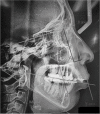Does maxillomandibular fixation affect skeletal stability following mandibular advancement? A single-blind clinical trial
- PMID: 35522330
- PMCID: PMC9076785
- DOI: 10.1186/s40902-022-00350-w
Does maxillomandibular fixation affect skeletal stability following mandibular advancement? A single-blind clinical trial
Abstract
Background: The stability of the results remains a significant concern in orthognathic surgeries. This study aimed to assess the amount of relapse following mandibular advancement with/without maxillomandibular fixation (MMF).
Materials and methods: A single-blind clinical trial was conducted on patients with mandibular retrognathism who underwent BSSO for mandibular advancement and Lefort I maxillary superior repositioning. Patients were randomly divided into two groups of treatment (MMF) and control (no MMF). In the treatment group, MMF was performed for 2 weeks; meanwhile, MMF was not performed in the control group, and only guiding elastics were applied postoperatively. Lateral cephalograms were obtained preoperatively (T1), immediately after surgery (T2), and at 1 year postoperatively (T3). The distance from points A and B to the X and Y plane were measured to identify the amount of vertical and horizontal relapse in 1 year as a primary outcome. An independent t-test was applied in order to find differences in outcomes between the control and treatment groups.
Results: Fifty-eight patients were evaluated in two groups (28 patients in the MMF group and 30 in the no-MMF group). The magnitude of mandibular advancement following BSSO was 7.68±1.39 mm and 7.53±1.28, respectively, without significant difference among the groups (p= 0.68). The mean sagittal and vertical changes (relapse) at point B were significantly different between the two groups at 1-year follow-up after the osteotomy (p=0.001 and p=0.05, respectively).
Conclusion: According to the results of this study, patients with short-term MMF following BSSO for mandibular advancement benefit from significantly greater skeletal stability in the sagittal and vertical dimensions.
Keywords: Bilateral sagittal split osteotomy; Orthognathic surgery; Skeletal class II malocclusion.
© 2022. The Author(s).
Conflict of interest statement
The authors declare that they have no competing interests.
References
-
- Tabrizi R, Nili M, Aliabadi E, Pourdanesh F. Skeletal stability following mandibular advancement: is it influenced by the magnitude of advancement or changes of the mandibular plane angle? J Korean Assoc Oral Maxillofac Surg. 2017;43(3):152–159. doi: 10.5125/jkaoms.2017.43.3.152. - DOI - PMC - PubMed
LinkOut - more resources
Full Text Sources

